Definition
Body systems are groups of organs and tissues that work together to perform important jobs for the body. Some organs may be part of more than one body system if they serve more than one function. Other organs and tissues serve a purpose in only one body system. Examples include the respiratory system, nervous system, and digestive system.
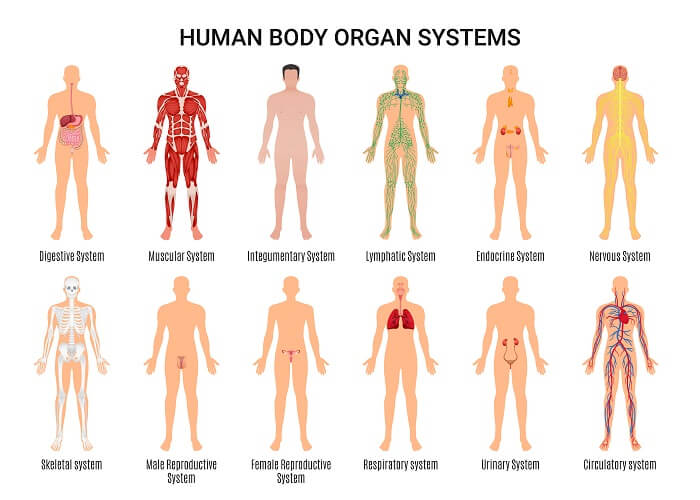
Overview of Body Systems
All body systems are necessary for a complex organism to be able to survive and reproduce. This article will focus on the systems of the human body; similar systems are required by all animals, but the details of how they accomplish their tasks may vary.
Functions that must be performed by an animal to stay alive include:
- Absorbing oxygen for use in cellular respiration
- Excreting carbon dioxide produced during cellular respiration
- Ingesting and processing food to obtain sugars and other nutrients.
- Transporting necessary substances, such as oxygen and nutrients, to all cells in the body
- Clearing toxic waste products from the body.
- Responding to changes in the environmental conditions
- Protecting the organs from the environment.
- Fighting pathogens
Additionally, for a species to survive, its individuals must be able to reproduce.
How do our organs and tissues work together as systems to accomplish these tasks?
List and Functions of Body Systems
Respiratory System
The respiratory system facilitates gas exchange between cells and the environment. The structures involved include the nasal passage, the trachea, and the lungs.
The respiratory system takes oxygen from the environment to be used throughout the body. In humans, oxygen is taken into the body by the lungs, where it and rapidly diffuses into the blood. The lungs accomplish this by passing large amounts of blood over gas exchange membranes. In fact, the body’s whole blood volume passes over these membranes about once per minute!
It could be argued that the respiratory system is one of the body’s most important. Without oxygen to fuel cellular respiration, cells begin to die within minutes. This is the primary reason that heart attacks are deadly. Although the heart is part of the circulatory system, not the respiratory system, it is responsible for transporting oxygen from the lungs to our cells. When the circulatory system stops working, our tissues begin to die from lack of oxygen. The lungs also expel carbon dioxide – a waste product of cellular respiration – which could otherwise build up to toxic levels.
Digestive System
The digestive system ingests food and breaks it down into usable nutrients before excreting solid waste products. It includes the mouth, esophagus, stomach, and intestines.
The digestive system takes in food and processes it to obtain useful nutrients that the body can use for fuel. Carbohydrates, proteins, and fats can all be used by our cells to obtain the energy they need to stay alive and carry out their functions. We can also get other important nutrients from food, such as essential amino acids (amino acids our bodies can’t make themselves), vitamins, and minerals that our cells need to make important biomolecules.
When food enters the body, it is first chewed by the mouth to break it down into a mush that stomach acids can penetrate. In the stomach, it is treated with acids and special enzymes that break the food’s components down into more useful forms.
Finally, it passes through the intestines: being squeezed through the huge surface area of the lower gastrointestinal tract to ensure as many useful nutrients are extracted from the food as possible. The digestive system also expels solid waste components of our food that our body can’t use in the form of fecal matter.
The liver helps the process of digestion by releasing substances that assist the stomach and intestines in breaking down food, and by breaking down toxic substances in the blood.
Once the nutrients have been extracted from foods, they are distributed to the body’s cells by the circulatory system.
Cardiovascular/Circulatory System
The cardiovascular system (sometimes called the circulatory system, which could also include the lymphatic system) is responsible for the transport of materials through the body. These substances include oxygen, nutrients, hormones, and waste products. The cardiovascular system includes the heart, the blood, and the blood vessels.
The cardiovascular system is a highly efficient system for moving substances around the body. The body’s entire blood volume takes about a minute to circulate – making this a truly high-speed expressway for distributing oxygen, nutrients, messages, and removing waste.
The heart is the central pump of the circulatory system, sending blood throughout the body at very high speeds. To ensure that we get enough oxygen, the heart even pumps blood through a special circuit to send large amounts of blood through the lungs quickly.
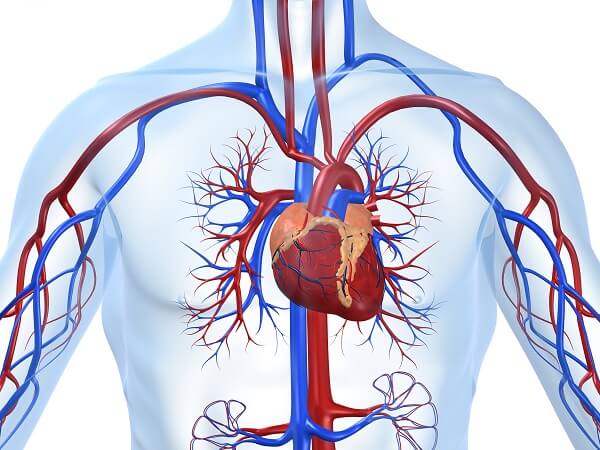
The arteries are the oxygen-delivery system that carry oxygenated blood through the body at high speeds and pressures. Arteries don’t just contain the blood; they have walls of smooth muscle which contract to help the blood moving, even far away from the heart. This is why injuries to arteries are so dangerous; if an artery is injured, the body’s whole blood volume can drain out through it very fast!
The veins are the second type of blood vessel. They are the highway that runs in the opposite direction to the arteries, returning deoxygenated blood to the return blood to the heart. The blood in veins moves a bit slower and at lower pressures.
At the finest level of the circulatory system, tiny blood vessels called capillaries carry blood all throughout the tissues. By passing blood flow close to every cell, the capillaries ensure the efficient delivery of all the required substances to every cell. Most bleeding from superficial cuts comes from blood seeping from these tiny, often microscopic, blood vessels.
In addition to oxygen and nutrients, the circulatory system also transports chemical messages, such as hormones, around the body. This allows the adrenal glands, for example, to send messages that cause our whole body to prepare for fight or flight.
Lastly, the cardiovascular system also performs the vital task of carrying waste products away from our cells. It delivers carbon dioxide to the lungs, and other toxins to the liver and kidneys to be destroyed or excreted.
Urinary System
The urinary system (sometimes called the renal system) extracts and excretes dissolved waste products from the blood. The main organs that function in the urinary system are the kidneys and bladder.
The urinary system keeps our body healthy by removing dangerous waste products from our blood and expelling them in the form of urine. It also functions to regulate the volume of fluid and the electrolyte balance in the body, ensuring homeostasis is maintained.
All blood is passed through the kidneys, where structures filter out dangerous substances and excess water while retaining useful substances. The waste liquid that is filtered out by the kidneys is delivered to and stored in the bladder by the ureter. The body expels it through the urethra.
Endocrine System
The endocrine system secretes chemical signals that allow body systems to respond to environmental changes and to one another . It includes hormone-producing tissues of the pineal gland and pituitary gland in the brain; the thyroid gland; the adrenal glands; the pancreas; and the ovaries, and testes.
The endocrine system consists of a number of tissues that send out chemical messages – called ‘hormones’ – to the rest of the body. Each of these messages has its own unique purpose, to which the body’s other systems respond accordingly.
The endocrine system allows the body to respond to environmental changes, and to other types of survival changes, such as the need to reproduce. Some examples of messages sent by the endocrine system are:
- Fight or flight response – When a threat appears in the environment, the adrenal glands secrete a flood of adrenaline. In response to this chemical message, the heart pumps blood faster, breathing deepens to take in more oxygen, and the nervous system sharpens perception and memory formation. Other changes also occur to make the body ready to fight or flee from a potential threat.
- Reproductive signals – When the body is ready to reproduce, the ovaries or testes send chemical messages that influence other organs, including the brain. In the female reproductive system, preparing the uterus for pregnancy involves a complex cascade of chemical messages that repeat on a monthly cycle – the menstrual cycle.
- Hungry or full – When the body is hungry, your stomach releases a hormone (called ghrelin) that tells the brain and other organ systems to start seeking food. When the body is full, on the other hand, another set of hormone messengers (including a hormone called leptin) are released to tell your body to stop eating.
Nervous System
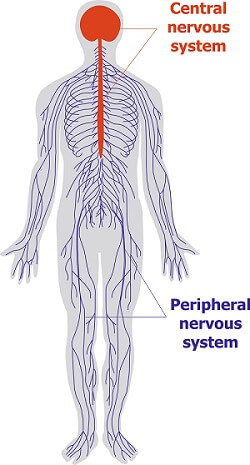
The nervous system allows us to perceive and respond to the world around us. This also includes our emotions and personality. The nervous system includes the brain, the brain stem, and all the nerves.
The nervous system allows us to sense and respond to stimuli, such as light, sound, smell, and touch from our environment. It also allows rapid communication of stimuli within our body.
It also includes the brain, a huge central processing unit that combines these stimuli into unified experiences. The brain allows us to perform tasks such as decision-making, recording memories, producing emotional responses, learning, and behavior.
The brain can be thought of as the control center that receives data, analyzes it, and then commands the body to respond.
The nervous system accomplishes all of this using highly specialized cells called neurons, which can transmit signals extremely rapidly by firing electrochemical potentials.
In order to fire these signals, neurons must use huge amounts of energy – as much as 25% of the calories we eat are used by the nervous system to allow us to perceive, feel, think, and respond!
Some scientists believe that our ancestors were not able to unlock our full potential until we were able to meet the huge energy needs of a big brain. Our ancestors were able to meet these needs by becoming good hunters, good cooks – which makes food easier to digest – and eventually developing agriculture.
Musculoskeletal system
The musculoskeletal system gives the body structure and allows us to move. We will first discuss the muscles before moving on to discuss the skeletal system.
The system of muscles throughout an organism operate to move the organism and stimulate the internal organs. There are three main types of muscles in a mammal: smooth muscle, skeletal muscle, and cardiac muscle.
Cardiac muscle is the muscle surrounding the heart and has a crucial function within the circulatory system. Cardiac muscle is different from both smooth muscle and skeletal muscle and is adapted to make contractions continuously. Smooth muscle is better at squeezing and surrounds the digestive tract to push food through. The skeletal muscle is best adapted to short bursts of strenuous exercise.
A portion of smooth muscle covers many internal organs and is responsible for holding certain passages shut, erecting hairs, and even moving food through the gut via an action called peristalsis. In a few cases, these muscles can be controlled voluntarily, but smooth muscle is generally controlled by the subconscious or autonomous nervous system. That is in direct contrast to skeletal muscles, which are almost entirely controlled by the somatic nervous system and require conscious control.
Skeletal muscles work by attaching to the skeleton and contracting or relaxing. When you make a fist, the muscles on the insides of your fingers are contracting, while the outside muscles relax and stretch out. When you fold your fingers out flat, the backside muscles are contracting. These opposite groups of muscles rely on the skeletal system to create forces. Thus, the systems are often combined and called the musculoskeletal system.
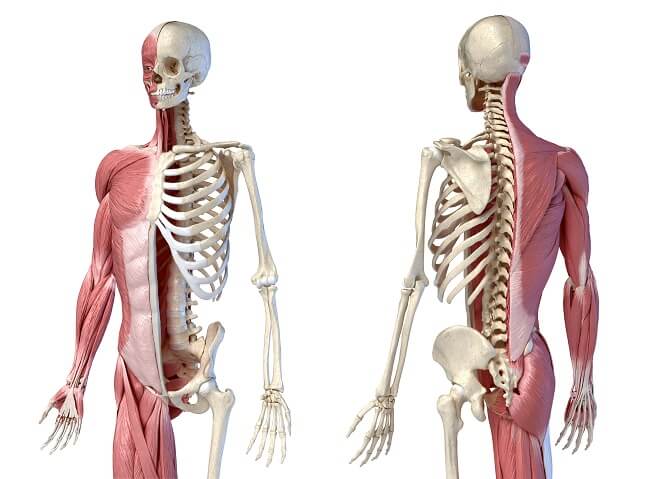
The skeletal system of animals consists of either an endoskeleton, like mammals, or an exoskeleton, seen in insects and other arthropods. Some animals also use water-pressure as a form of a skeleton, known as a hydrostatic skeleton. Whatever form of the skeleton is used, the skeletal system has the same purpose, to provide support and attachment for the muscles.
To move a limb, muscles on one side must be extended, while on the other side they are shortened. Working together, the muscles and skeleton permit movement of an animal. Besides support and attachment for the muscles, the skeletal system is also a very important protective measure. For example, our cranium is a series of interconnected bones that serve to encase and protect our brain from damage. The rib cage is a series of bones that extends around the thoracic cavity to protect the heart and lungs. Therefore, our skeleton also protects our most vital organs.
Integumentary System/Exocrine System
These systems cover the body and regulate its exchange with the outside world. This includes the skin, hair, nails, sweat, and other glands that secrete substances onto the skin.
Like the famous saying, skin keeps our insides in! It also keeps everything else out. Skin is our body’s first line of defense against pathogens, harmful substances, injuries, and more. It also controls how much heat and water our body loses to the environment, allowing us to sweat. Even goosebumps are part of our skin’s regulation system; the tightening of the skin raises our fine hairs upright, trapping warm air close to our skin.
The skin is a surprisingly complex material, which scientists have not been able to reproduce artificially. This is because it is a dynamic tissue, which is constantly maintained by the nourishing circulatory system underneath; and by a number of glands on the outside of our skin, which secrete oils and other substances that keep our skin from drying and cracking.
Fun fact: skin is also the largest organ in the body. Or perhaps we should say, the largest organ on the body.
Lymphatic System/Immune System
The lymphatic system includes the circulatory and immune systems. The lymphatic system is responsible for absorbing fat from the digestive system, maintaining fluid balance, and supporting the cells of the immune system.
Every living thing needs to be able to fight invasion by foreign particles. This is because every organism that is made of delicious carbohydrates, proteins, and lipids has another organism that wants to take advantage. Some of these organisms are large predators, but most are microscopic pathogens that can easily fit inside us.
In the case of animals, we have white blood cells that can specifically target and destroy invading pathogens. These white blood cells are made in our bone marrow and stored in our blood and our lymphatic systems.
The lymphatic system is a circulatory system separate from the cardiovascular system. It carries water, white blood cells, and other substances, but it does not have red blood cells or platelets. Because it is not the body’s main carrier of oxygen, lymph can move more slowly than the bloodstream – giving the white blood cells more time to find and attack invaders.
“Lymph nodes” are nexuses in the lymphatic system where white blood cells can cluster and attack invading pathogens. Sometimes, when we’re sick, our lymph nodes – such as those behind the ears, under the jaw, and in the armpits and groin – can become painful and swollen as our immune systems fight the infections in these nodes.
Reproductive System
The reproductive system facilitates the production of offspring. It includes, for example, the ovaries, uterus, mammary glands (breasts), penis, and testes.
The reproductive system is not essential to individual survival, but it is essential for the survival of the species. After all, a species whose members couldn’t reproduce would not last very long!
In humans, there are two very different reproductive systems: the male system, which is primarily concerned with producing sperm and finding mates; and the female system, which must prepare for pregnancy, childbirth, and baby care for reproduction to be successful.
The female reproductive system is a particularly fascinating study in the way body systems work together to ensure our survival. Throughout the course of a woman’s menstrual cycle, her body uses four different hormones – most of which are produced by her ovaries – to decide when and whether her body should prepare for pregnancy.
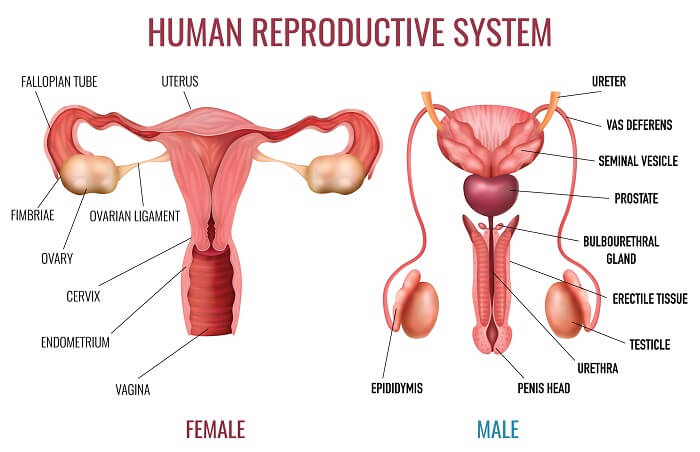
The major effects of the reproductive hormones are on the reproductive organs themselves, which must bring eggs for maturity and prepare uterine lining, rich in blood vessels, to nurture a possible embryo.
However, effects are also seen in other organ systems. As the menstrual cycle progresses, the hormones may alter the body temperature; blood flow; and even the appetite and attraction to the opposite sex, to ensure that all the right resources are in place at the right time for reproduction to proceed.
Women in some parts of the world have been known to develop bizarre eating habits due to the demands of their reproductive cycle. In areas with poor nutrition, for example, the monthly shedding of the blood-rich uterine lining can cause deficiencies of the minerals found in the blood. As a result, women in these areas may actually eat clay from the ground to ensure these minerals are replenished!
We may not see such clear examples of our body systems interacting on a daily basis; but the organs and tissues that make up our body systems are always communicating, and working together, to keep us and our species alive and healthy.
Quiz
